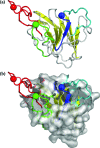All three variable regions of the TRIM5alpha B30.2 domain can contribute to the specificity of retrovirus restriction
- PMID: 16912305
- PMCID: PMC1563890
- DOI: 10.1128/JVI.00688-06
All three variable regions of the TRIM5alpha B30.2 domain can contribute to the specificity of retrovirus restriction
Abstract
Recent studies have revealed the contribution of TRIM5alpha to retrovirus restriction in cells from a variety of primate species. TRIM5alpha consists of a tripartite motif (the RBCC domain) followed by a B30.2 domain. The B30.2 domain is thought to be involved in determination of restriction specificity and contains three variable regions. To investigate the relationship between the phylogeny of primate TRIM5alpha and retrovirus restriction specificity, a series of chimeric TRIM5alpha consisting of the human RBCC domain followed by the B30.2 domain from various primates was constructed. These constructs showed restriction profiles largely consistent with the origin of the B30.2 domain. Restriction specificity was further investigated with a variety of TRIM5alphas containing mixed or mutated B30.2 domains. This study revealed the importance of all three variable regions for determining restriction specificity. Based on the molecular structures of other PRYSPRY domains solved recently, a model for the molecular structure of the B30.2 domain of TRIM5alpha was developed. The model revealed that the variable regions of the B30.2 domain are present as loops located on one side of the B30.2 core structure. It is hypothesized that these three loops form a binding surface for virus and that evolutionary changes in any one of the loops can alter restriction specificity.
Figures







References
-
- Bainbridge, J. W., C. Stephens, K. Parsley, C. Demaison, A. Halfyard, A. J. Thrasher, and R. R. Ali. 2001. In vivo gene transfer to the mouse eye using an HIV-based lentiviral vector: efficient long-term transduction of corneal endothelium and retinal pigment epithelium. Gene Ther. 8:1665-1668. - PubMed
-
- Benit, L., N. De Parseval, J. F. Casella, I. Callebaut, A. Cordonnier, and T. Heidmann. 1997. Cloning of a new murine endogenous retrovirus, MuERV-L, with strong similarity to the human HERV-L element and with a gag coding sequence closely related to the Fv1 restriction gene. J. Virol. 71:5652-5657. - PMC - PubMed
Publication types
MeSH terms
Substances
Associated data
- Actions
- Actions
- Actions
- Actions
- Actions
- Actions
- Actions
- Actions
- Actions
- Actions
- Actions
- Actions
Grants and funding
LinkOut - more resources
Full Text Sources

